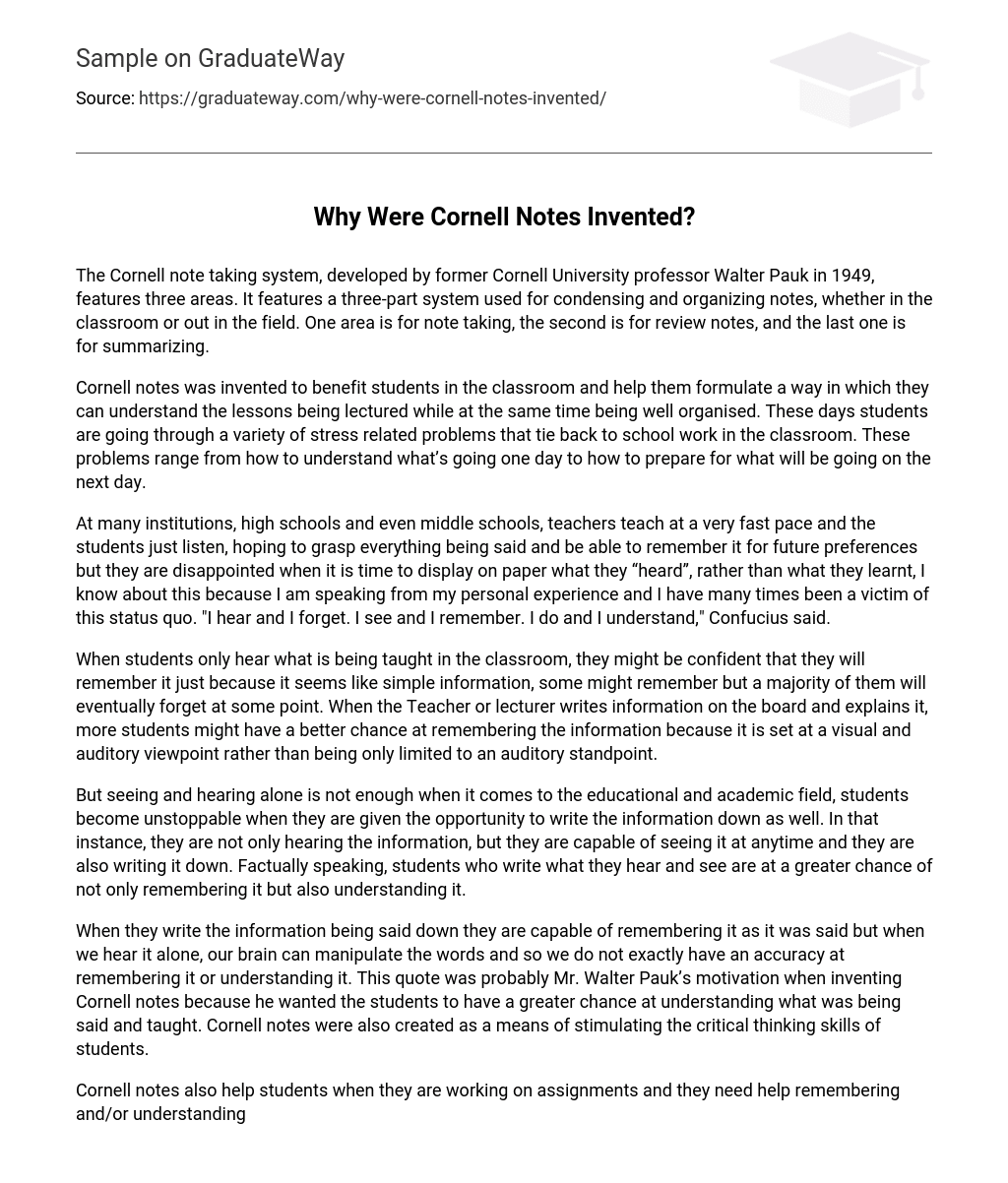The Cornell note taking system was developed by Walter Pauk in 1949 to condense and organize notes in different settings, like classrooms or outdoor environments. It comprises three sections: note-taking, note reviewing, and summarizing.
Cornell notes were created to aid students in the classroom and provide them with a method to comprehend the lessons being taught while also maintaining organization. Nowadays, students encounter various stress-related issues that are linked to their school work. These problems can range from comprehending current lectures to preparing for upcoming ones.
Many institutions, high schools, and even middle schools adhere to a teaching method in which teachers talk quickly while students passively listen, hoping to comprehend and remember the information for later use. Unfortunately, students are frequently frustrated when they are expected to write down what they “heard” rather than what they actually learned. I can personally empathize with this occurrence as I have often fallen prey to this prevalent situation. As Confucius sagely proclaimed, “I hear and I forget. I see and I remember. I do and I understand.”
When students hear the information solely in the classroom, they may assume they will remember it because it seems straightforward. However, many will eventually forget. By writing and explaining information on the board, teachers give students a visual and auditory perspective, increasing the likelihood of retention compared to solely relying on auditory methods.
However, in the educational and academic field, it is not enough to solely perceive information through sight and hearing. Students excel when they have the opportunity to document the information by writing it down. This enables them to both comprehend and visually reference the information whenever necessary. In reality, students who transcribe what they hear and see have a greater chance of retaining and understanding the information.
Writing down information allows us to remember it more accurately, while hearing alone may lead to less accurate memory and understanding due to our brain manipulating the words. This likely inspired Mr. Walter Pauk to create Cornell notes, aiming to enhance students’ comprehension and recall of information. Furthermore, Cornell notes were intended to foster critical thinking skills in students.
Cornell notes are useful for students who need assistance recalling and comprehending classroom information while working on assignments. The primary purpose of Cornell notes is to aid in preparation; students can refer to a specific set of Cornell notes for a particular class when studying for an upcoming test. These notes serve as an excellent study guide in cases where the teacher or lecturer has not provided one.
The motivation behind Mr. Walter Pauk’s invention and development of Cornell notes was the frustration experienced by students due to the absence of study guides, resulting in lower test scores. Another factor that led to the creation of Cornell notes was the need for better organization.
Cornell notes address the issue of disorganized note-taking, which is a common problem for both students and teachers. With designated sections for notes, main ideas, and summaries, Cornell notes encourage clear organization. This prevents the chaos of having various ideas spread across one page. However, just taking notes is insufficient for achieving success. The way in which notes are taken ultimately determines the student’s outcome.
Cornell notes have evolved significantly since their initial release in 1949 and have gained widespread popularity. These notes not only promote students’ accountability for their learning but also heavily depend on what they choose to include and how they use them, ultimately shaping their educational experience. Whether in terms of organization or preparation, Cornell notes continue to have a profound and positive impact on students’ academic lives.
Students are benefiting from Mr. Walter Pauk’s invention of Cornell Notes in their grades and learning, experiencing its positive impact every day. This systematic approach remains highly advantageous for addressing students’ weaknesses and has revealed additional benefits over time.
Work Cited
http://en.wikipedia.org/wiki/Cornell_Notes
weblink.scsd.us/~liblinks/AVID/AVID%20notesresource.ppt
The following sources were used:





